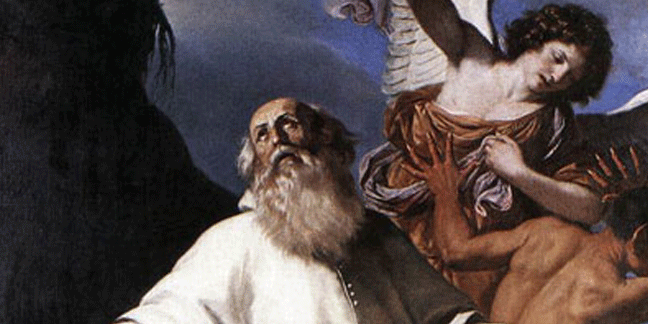"The heart has always been seen as the 'center' or essence a person ('the heart of the matter,' 'you are my heart,' 'take it to heart,' etc.) and the wellspring of our emotional lives and love ('you break my heart,' 'my heart sings,' etc.). Devotion to the Sacred Heart of Jesus is devotion to Jesus Christ Himself, but in the particular ways of meditating on His interior life and on His threefold love – His divine love, His burning love that fed His human will, and His sensible love that affects His interior life," Pope Pius XII wrote in his 1956 encyclical "Haurietis Aquas" ("On Devotion To The Sacred Heart").
The Friday following the second Sunday after Pentecost is the Feast of the Sacred Heart. On the Feast of the Sacred Heart, we can gain a plenary indulgence by making an Act of Reparation to the Sacred Heart.
From the earliest days of the Church, writes the Catholic Encyclopedia, "Christ's open side and the mystery of blood and water were meditated upon, and the Church was beheld issuing from the side of Jesus, as Eve came forth from the side of Adam. It is in the 11th and 12th centuries that we find the first unmistakable indications of devotion to the Sacred Heart. Through the wound in the side, the wound in the Heart was gradually reached, and the wound in the Heart symbolized the wound of love."
This general devotion arose first in Benedictine and Cistercian monasteries of that time, but specific devotions became popularized when St. Margaret Mary Alacoque (1647-1690), a Visitation nun, had a personal revelation involving a series of visions of Christ as she prayed before the Blessed Sacrament. She wrote, "He disclosed to me the marvels of His Love and the inexplicable secrets of His Sacred Heart." Christ emphasized to her His love – and His woundedness caused by man's indifference to this love.
— Catholic News Agency
 St. Romuald, who founded the Camaldolese monastic order during the early 11th century, has his liturgical memorial on June 19.
St. Romuald, who founded the Camaldolese monastic order during the early 11th century, has his liturgical memorial on June 19.
Working within the Western Church's Benedictine tradition, he revived the primitive monastic practice of hermit life, allowing for greater solitude in a communal setting.
Born into an aristocratic Italian family during the middle of the 10th century, Romuald grew up in a luxurious and worldly environment, where he learned little in the way of self-restraint or religious devotion. Yet he also felt an unusual attraction toward the simplicity of monastic life, prompted by the beauty of nature and the experience of solitude.
It was not beauty or tranquility, but a shocking tragedy that spurred him to act on this desire. When Romuald was 20 years old, he saw his father Sergius kill one of his relatives in a dispute over some property. Disgusted by the crime he had witnessed, the young man went to the Monastery of St. Apollinaris to do 40 days of penance for his father.
These 40 days confirmed Romuald's monastic calling, as they became the foundation for an entire life of penance. But this would not be lived out at St. Apollinaris, where Romuald's strict asceticism brought him into conflict with some of the other monks. He left the area near Ravenna and went to Venice, where he became the disciple of the hermit Marinus.
Both men went on to encourage the monastic vocation of Peter Urseolus, a Venetian political leader who would later be canonized as a saint. When Peter joined a French Benedictine monastery, Romuald followed him and lived for five years in a nearby hermitage.
In the meantime, Romuald's father Sergius had followed his son's course, repenting of his sins and becoming a monk himself. Romuald returned to Italy to help his father, after learning that Sergius was struggling in his vocation. Through his son's guidance, Sergius found the strength to persist in religious life.
After guiding his penitent father in the way of salvation, Romuald traveled throughout Italy serving the Church. By 1012 he had helped to establish or reform almost 100 hermitages and monasteries, though these were not connected to one another in the manner of a distinct religious order.
The foundations of the Camaldolese order were not laid until 1012 – when a piece of land called the "Camaldoli," located in the Diocese of Arezzo, was granted to Romuald. It became the site of five hermits' quarters, and a full monastery soon after. This combination of hermits' cells and community life, together with other distinctive features, gave this monastery and its later affiliates a distinct identity and charism.
Romuald's approach to the contemplative life, reminiscent of the early Desert Fathers, can be seen in the short piece of writing known as his "Brief Rule." It reads as follows:
"Sit in your cell as in paradise. Put the whole world behind you and forget it. Watch your thoughts like a good fisherman watching for fish. The path you must follow is in the Psalms – never leave it."
"If you have just come to the monastery, and in spite of your good will you cannot accomplish what you want, take every opportunity you can to sing the Psalms in your heart and to understand them with your mind. And if your mind wanders as you read, do not give up; hurry back and apply your mind to the words once more."
"Realize above all that you are in God's presence, and stand there with the attitude of one who stands before the emperor. Empty yourself completely and sit waiting, content with the grace of God, like the chick who tastes nothing and eats nothing but what his mother brings him."
St. Romuald of Ravenna died in his monastic cell on June 19, 1027. Pope Gregory XIII canonized him in 1582.
— Catholic News Agency

